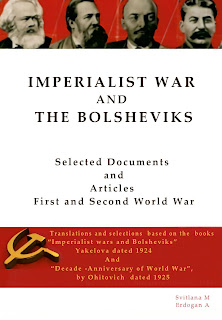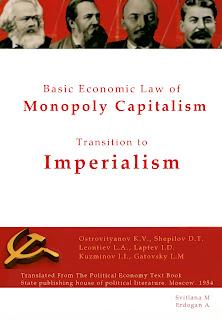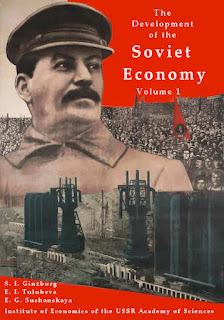DIFFICULTIES IN THE PERIOD OF SOCIALIST INDUSTRIALIZATION 1926 - 1929
CHAPTER TEN
THE BOLSHEVIK PARTY IN THE STRUGGLE FOR
THE SOCIALIST INDUSTRIALIZATION OF THE COUNTRY
(1926 - 1929)
1. DIFFICULTIES IN THE PERIOD OF SOCIALIST INDUSTRIALIZATION AND THE FIGHT TO OVERCOME THEM. FORMATION OF THE ANTI-PARTY BLOC OF TROTSKYITES AND ZINOVIEVITES. ANTI-SOVIET ACTIONS OF THE BLOC. DEFEAT OF THE BLOC
After the Fourteenth Congress, the Party launched a vigorous struggle for the realization of the general line of the Soviet Government — the Socialist industrialization of the country.
In the restoration period the task had been to revive agriculture before all else, so as to obtain raw materials and foodstuffs, to restore and to set going the industries, the existing mills and factories.
The Soviet Government coped with this task with comparative ease.
But in the restoration period there were three major shortcomings:
First, the mills and factories were old, equipped with worn-out and antiquated machinery, and might soon go out of commission. The task now was to re-equip them on up-to-date lines.
Secondly, industry in the restoration period rested on too narrow a foundation: it lacked machine-building plants absolutely indispensable to the country. Hundreds of these plants had to be built, for without them no country can be considered as being really industrialized. The task now was to build these plants and to equip them on up-to-date lines.
Thirdly, the industries in this period were mostly light industries. These were developed and put on their feet. But, beyond a certain point, the further development even of the light industries met an obstacle in the weakness of heavy industry, not to mention the fact that the country had other requirements which could be satisfied only by a well-developed heavy industry. The task now was to tip the scales in favour of heavy industry.
All these new tasks were to be accomplished by the policy of Socialist industrialization.
It was necessary to build up a large number of new industries, industries which had not existed in tsarist Russia—new machinery, machine-tool, automobile, chemical, and iron and steel plants—to organize the production of engines and power equipment, and to increase the mining of ore and coal. This was essential for the victory of Socialism in the U.S.S.R.
It was necessary to create a new munitions industry, to erect new works for the production of artillery, shells, aircraft, tanks and machine guns. This was essential for the defence of the U.S.S.R., surrounded as it was by a capitalist world.
It was necessary to build tractor works and plants for the production of modern agricultural machinery, and to furnish agriculture with these machines, so as to enable millions of small individual peasant farms to pass to large-scale collective farming. This was essential for the victory of Socialism in the countryside.
All this was to be achieved by the policy of industrialization, for that is what the Socialist industrialization of the country meant.
Clearly, construction work on so large a scale would necessitate the investment of thousands of millions of rubles. To count on foreign loans was out of the question, for the capitalist countries refused to grant loans. We had to build with our own resources, without foreign assistance. But we were then a poor country.
There lay one of the chief difficulties.
Capitalist countries as a rule built up their heavy industries with funds obtained from abroad, whether by colonial plunder, or by exacting indemnities from vanquished nations, or else by foreign loans. The Soviet Union could not as a matter of principle resort to such infamous means of obtaining funds as the plunder of colonies or of vanquished nations. As for foreign loans, that avenue was closed to the U.S.S.R., as the capitalist countries refused to lend it anything. The funds had to be found inside the country.
And they were found. Financial sources were tapped in the U.S.S.R. such as could not be tapped in any capitalist country. The Soviet state had taken over all the mills, factories, and lands which the October Socialist Revolution had wrested from the capitalists and landlords, all the means of transportation, the banks, and home and foreign trade. The profits from the state-owned mills and factories, and from the means of transportation, trade and the banks now went to further the expansion of industry, and not into the pockets of a parasitic capitalist class.
The Soviet Government had annulled the tsarist debts, on which the people had annually paid hundreds of millions of gold rubles in interest alone. By abolishing the right of the landlords to the land, the Soviet Government had freed the peasantry from the annual payment of about 500,000,000 gold rubles in rent. Released from this burden, the peasantry was in a position to help the state to build a new and powerful industry. The peasants had a vital interest in obtaining tractors and other agricultural machinery.
All these sources of revenue were in the hands of the Soviet state. They could yield hundreds and thousands of millions of rubles for the creation of a heavy industry. All that was needed was a business-like approach, the strictly economical expenditure of funds, rationalization of industry, reduction of costs of production, elimination of unproductive expenditure, etc.
And this was the course the Soviet Government adopted.
Thanks to a regime of strict economy, the funds available for capital development increased from year to year. This made it possible to start on gigantic construction works like the Dnieper Hydro-Electric Power Station, the Turkestan-Siberian Railway, the Stalingrad Tractor Works, a number of machine-tool works, the AMO (ZIS) Automobile Works and others.
Whereas in 1926-27 about 1,000,000,000 rubles were invested in industry, three years later it was found possible to invest about 5,000,000,000 rubles.
Industrialization was making steady headway.
The capitalist countries looked upon the growing strength of the Socialist economic system in the U.S.S.R. as a threat to the existence of the capitalist system. Accordingly, the imperialist governments did everything they could to bring new pressure to bear on the U.S.S.R., to create a feeling of uncertainty and uneasiness in the country, and to frustrate, or at least to impede, the industrialization of the U.S.S.R.
In May 1927, the British Conservative Die-hards, then in office, organized a provocative raid on Arcos (the Soviet trading body in Great Britain). On May 26, 1927, the British Conservative Government broke off diplomatic and trade relations with the U.S.S.R.
On June 7, 1927, Comrade Voikov, the Soviet Ambassador in Warsaw, was assassinated by a Russian Whiteguard, a naturalized Polish subject.
About this time, too, in the U.S.S.R. itself, British spies and diversionists hurled bombs at a meeting in a Party club in Leningrad, wounding about 30 people, some of them severely.
In the summer of 1927, almost simultaneous raids were made on the Soviet Embassies and Trade Representations in Berlin, Peking, Shanghai and Tientsin.
This created additional difficulties for the Soviet Government.
But the U.S.S.R. refused to be intimidated and easily repulsed the provocative attempts of the imperialists and their agents.
No less were the difficulties caused to the Party and the Soviet state by the subversive activities of the Trotskyites and other oppositionists. Comrade Stalin had good reason to say that "something like a united front from Chamberlain to Trotsky is being formed" against the Soviet Government. In spite of the decisions of the Fourteenth Party Congress and the professions of loyalty of the oppositionists, the latter had not laid down their arms. On the contrary, they intensified their efforts to undermine and split the Party.
In the summer of 1926, the Trotskyites and Zinovievites united to form an anti-Party bloc, made it a rallying point for the remnants of all the defeated opposition groups, and laid the foundation of their secret anti-Leninist party, thereby grossly violating the Party Rules and the decisions of Party congresses forbidding the formation of factions. The Central Committee of the Party gave warning that unless this anti-Party bloc—which resembled the notorious Menshevik August Bloc— were dissolved, matters might end badly for its adherents. But the supporters of the bloc would not desist.
That autumn, on the eve of the Fifteenth Party Conference, they made a sortie at Party meetings in the factories of Moscow, Leningrad and other cities, attempting to force a new discussion on the Party. The platform they tried to get the Party members to discuss was a rehash of the usual Trotskyite-Menshevik anti-Leninist platform. The Party members gave the oppositionists a severe rebuff, and in some places simply ejected them from the meetings. The Central Committee again warned the supporters of the bloc, stating that the Party could not tolerate their subversive activities any longer.
The opposition then submitted to the Central Committee a statement signed by Trotsky, Zinoviev, Kamenev and Sokolnikov condemning their own factional work and promising to be loyal in the future. Nevertheless, the bloc continued to exist and its adherents did not stop their underhand work against the Party. They went on banding together their anti-Leninist party, started an illegal printing press, collected membership dues from their supporters and circulated their platform.
In view of the behaviour of the Trotskyites and Zinovievites, the Fifteenth Party Conference (November 1926) and the Enlarged Plenum of the Executive Committee of the Communist International (December 1926) discussed the question of the bloc of Trotskyites and Zinovievites and adopted resolutions stigmatizing the adherents of this bloc as splitters whose platform was downright Menshevism.
But even this failed to bring them to their senses. In 1927, just when the British Conservatives broke off diplomatic and trade relations with the U.S.S.R., the bloc attacked the Party with renewed vigour. It concocted a new anti-Leninist platform, the so-called "Platform of the Eighty-Three" and began to circulate it among Party members, at the same time demanding that the Central Committee open a new general Party discussion.
This was perhaps the most mendacious and pharisaical of all opposition platforms.
In their platform, the Trotskyites and Zinovievites professed that they had no objection to observing Party decisions and that they were all in favour of loyalty, but in reality they grossly violated the Party decisions, and scoffed at the very idea of loyalty to the Party and to its Central Committee.
In their platform, they professed they had no objection to Party unity and were against splits, but in reality they grossly violated Party unity, worked for a split, and already had their own, illegal, anti-Leninist party which had all the makings of an anti-Soviet, counter-revolutionary party.
In their platform, they professed they were all in favour of the policy of industrialization, and even accused the Central Committee of not proceeding with industrialization fast enough, but in reality they did nothing but carp at the Party resolution on the victory of Socialism in the U.S.S.R., scoffed at the policy of Socialist industrialization, demanded the surrender of a number of mills and factories to foreigners in the form of concessions, and pinned their main hopes on foreign capitalist concessions in the U.S.S.R.
In their platform, they professed they were all in favour of the collective-farm movement, and even accused the Central Committee of not proceeding with collectivization fast enough, but in reality they scoffed at the policy of enlisting the peasants in the work of Socialist construction, preached the idea that "unresolvable conflicts" between the working class and the peasantry were inevitable, and pinned their hopes on the "cultured leaseholders" in the countryside, in other words, on the kulaks.
This was the most mendacious of all the platforms of the opposition. It was meant to deceive the Party.
The Central Committee refused to open a general discussion immediately. It informed the opposition that a general discussion could be opened only in accordance with the Party Rules, namely, two months before a Party congress.
In October 1927, that is, two months before the Fifteenth Congress, the Central Committee of the Party announced a general Party discussion, and the fight began. Its result was truly lamentable for the bloc of Trotskyites and Zinovievites: 724,000 Party members voted for the policy of the Central Committee; 4,000, or less than one per cent, for the bloc of Trotskyites and Zinovievites. The anti-Party bloc was completely routed. The overwhelming majority of the Party members were unanimous in rejecting the platform of the bloc.
Such was the clearly expressed will of the Party, for whose judgment the oppositionists themselves had appealed.
But even this lesson was lost on the supporters of the bloc. Instead of submitting to the will of the Party they decided to frustrate it. Even before the discussion had closed, perceiving that ignominious failure awaited them, they decided to resort to more acute forms of struggle against the Party and the Soviet Government and to stage an open demonstration of protest in Moscow and Leningrad. The day they chose for their demonstration was November 7, the anniversary of the October Revolution, the day on which the working people of the U.S.S.R. annually hold their countrywide revolutionary demonstration. Thus, the Trotskyites and Zinovievites planned to hold a parallel demonstration. As was to be expected, the supporters of the bloc managed to bring out into the streets only a miserable handful of their satellites. These satellites and their patrons were overwhelmed by the general demonstration and swept off the streets.
Now there was no longer any doubt that the Trotskyites and Zinovievites had become definitely anti-Soviet. During the general Party discussion they had appealed to the Party against the Central Committee; now, during their puny demonstration, they had taken the course of appealing to the hostile classes against the Party and the Soviet state. Once they had made it their aim to undermine the Bolshevik Party, they were bound to go to the length of undermining the Soviet state, for in the Soviet Union the Bolshevik Party and the state are inseparable. That being the case, the ringleaders of the bloc of Trotskyites and Zinovievites had outlawed themselves from the Party, for men who had sunk to the depths of anti-Soviet action could no longer be tolerated in the ranks of the Bolshevik Party.
On November 14, 1927, a joint meeting of the Central Committee and the Central Control Commission expelled Trotsky and Zinoviev from the Party.

























.jpg)








